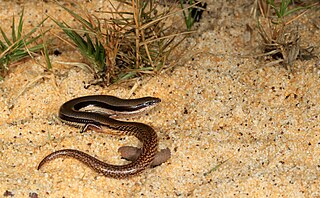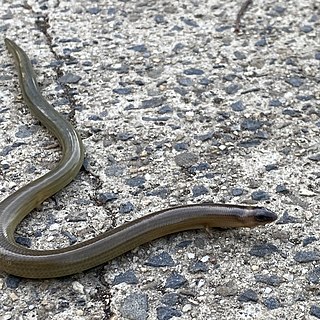
Anomalopus is a genus of worm-skinks, smallish smooth-scaled burrowing lizards in the family Scincidae. The genus is endemic to the eastern half of Australia. The genus belongs to a clade in the Sphenomorphus group which contains such genera as Ctenotus and the close relatives Eulamprus and Gnypetoscincus.
Glaphyromorphus is a genus of lizards in the skink family (Scincidae).

Lerista is a diverse genus of skinks endemic to Australia, commonly known as sliders.
Nangura spinosa, the Nangur spiny skink or Nangur skink, is a lizard known from two patches of dry-rainforest in South East Queensland, Australia. It was formerly placed in the monotypic genus Nangura but was moved to Concinnia following the molecular phylogenetic studies of O'Connor & Moritz (2003) and Skinner and co-authors (2013). It was returned to Nangura in 2018. This species is known only from two localities; the type locality, now in Nangura National Park, and a much smaller isolated population in Oakview National Park and adjacent Oakview State Forest. The total distribution spans just 42 square kilometers, within which this species occupies less than 4 square kilometers, with an estimated population size of less than 200 individuals. It is threatened by invasive species including cats, pigs, dogs, foxes and cane toads, by the invasive plant species Lantana camara, which increases fire risk and changes forest structure, and in some sites by logging and road maintenance. Consequently, it is listed as critically endangered under the Australian Environment Protection and Biodiversity Conservation Act 1999 It resembles Gnypetoscincus queenslandiae in its spiny scales and like that species it is live bearing. Along with minor differences in scalation, the Nangur spiny skink differs from other Australian Sphenomorphid skinks in its karyotype of 2n=28 chromosomes, where most others have 2n=30. It is also unlike related species in that it lives in burrows, which occur in small colonies through the dry rainforest habitat. There is some indication of parental care in this species, with adults sharing burrows with juveniles.
Anomalopus mackayi, commonly known as the five-clawed worm skink, long-legged worm skink, and Mackay's burrowing skink, is a species of smooth-scaled burrowing skink, a lizard in the family Scincidae. The species is endemic to eastern Australia.
Allan's lerista, also known commonly as Allan's skink and the greater robust fine-lined slider, is a species of skink, a lizard in the family Scincidae. This rare species is endemic to Queensland, Australia.
Anomalopus swansoni, also known commonly as the punctate worm-skink or Swanson's burrowing skink, is a species of lizard in the family Scincidae. The species is endemic to Australia.
Orraya is a monotypic genus of lizard in the family Carphodactylidae. The genus contains the sole species Orraya occultus, also known commonly as the McIlwraith leaf-tailed gecko or the long-necked northern leaf-tailed gecko. The species is endemic to Australia.
Cyrtodactylus hoskini is a species of gecko, a lizard in the family Gekkonidae. The species is endemic to Australia.
Cyrtodactylus mcdonaldi is a species of gecko, a lizard in the family Gekkonidae. The species is endemic to Queensland in Australia.
The Quinkan ctenotus is a species of Australian skink, a lizard in the family Scincidae.

Carlia dogare, the sandy rainbow skink, is a species of skink in the genus Carlia. It is native to Queensland in Australia.

Pseudemoia baudini, also known commonly as Baudin's skink, Baudin's window-eyed skink, and the Bight Coast skink, is a species of lizard in the family Scincidae. The species is endemic to Australia.
The short-necked worm-skink is a species of skink found in Queensland in Australia. It has a similar resemblance to an Earthworm.
Praeteropus gowi, also known commonly as Gow's burrowing skink and the speckled worm-skink, is a species of lizard in the family Scincidae. The species is endemic to Queensland in Australia.

Anomalopus verreauxii, also known commonly as the three-clawed worm-skink or Verreaux's skink, is a species of lizard in the family Scincidae. The species is endemic to Australia.
Concinnia frerei, also known commonly as the stout bar-sided skink or the stout barsided skink, is a species of lizard in the family Scincidae. The species is endemic to Queensland in Australia.
The nubbinned fine-lined slider is a species of skink, a lizard in the family Scincidae. The species is endemic to Queensland in Australia.
Lerista emmotti, also known commonly as the Noonbah robust slider, is a species of skink, a lizard in the family Scincidae. The species is endemic to Queensland in Australia.
Lerista wilkinsi, also known commonly as the two-toed fine-lined slider and Wilkins' lerista, is a species of skink, a lizard in the family Scincidae. The species is endemic to Queensland in Australia.




